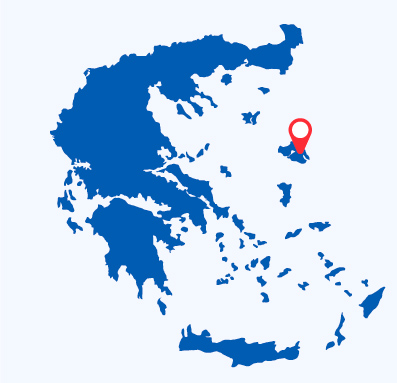Lesbos also called Lesvos by the Hellenic people is located in the north of Greece very close to the Turkish coasts.
The third largest of all the Greek islands, it covers an area of over 1600 square kilometres. With volcanic origins and a rich and constantly changing morphology, despite its beauty it is little visited by tourism, in recent years above all due to its unfortunate position which, being very close to the East and Turkey, is a land of immigration.
The most courageous but not for any danger factor but only for a question of undertaking a journey given that there are no direct flights from Italy and almost all of Europe and who want to visit a part of Greece that is still almost unknown, they will find a great surprise because Lesbos has absolutely nothing missing and perhaps has much more to offer than the more famous islands.
A territory that in history has suffered several earthquakes which have changed its shape but which have contributed to giving life to a corner of paradise. There are many mountains, the highest being the Lepetimno massif in the north with the peak of Profitis Elia (968 metres) which stands out above them all. Dense pine forests, endless expanses of olive trees, oaks, chestnut trees and vegetation that offers an innumerable quantity of species. There are no rivers or lakes, on the other hand you can admire fantastic waterfalls (especially in the south) and miraculous thermal springs known for millennia with healing properties for many pathologies such as rheumatism which attract many Greeks every year.
Lesbos is also right on one of the main migratory routes, the salt mines of Kaloni towards the west, are the residence of fifty pairs of herons as well as other specimens of birds, in some cases very rare. In the caves of Skala, on the western side, the monachus seals of the Mediterranean, unfortunately in danger of extinction, find refuge, and in the monastery of Limoas the area has been declared protected as they host wild birds.
The island is also known for being the birthplace of the poet Sappho, originally from Eresos. After spending about ten years in Sicily with her family in exile, she returned to Lesbos where she became director and teacher of a religious association dedicated to the God Dionysus in a sort of boarding school where, according to the story, she had love affairs with some of the girls. Then following an unrequited love towards Faone who left her 'for another, she out of desperation committed suicide' in Porto Katsiki in Lefkada by throwing herself off the cliff.
Hence the saying "sapphic or lesbian love" to indicate female homosexuality.
One of the excellent products of Lesbos is the oil which is obtained from the cultivation of the many olive groves on the island, another is the wine produced especially in the Plomari area in the south east and last but not least the most famous liqueur of all over Greece, who hasn't drank at least one glass? Its inhabitants are very kind and open towards foreigners but they are also very attached to their roots so much so that traditions are still very present in daily life, handed down from generation to generation.
A visit to the capital Mytilini is a must! Shaped like an amphitheatre, it boasts a beautiful castle from the 14th century Byzantine era on the pine-covered hill that completely dominates the beautiful bay that welcomes it. Old houses and modern buildings which, despite their differences, do not clash with each other but rather give them that particular touch. Noisy and full of life with its large port where visitors disembark, it offers travelers excellent cuisine and many cultural points such as churches and museums not to mention its seafront promenade, the center of the city. To the north east of Mytilini is the ancient theater from the Hellenistic period which can accommodate up to 10,000 spectators with stunning acoustics.
Unmissable is the petrified forest in Sigri in the north-west, formed by a frightening volcanic explosion twenty million years ago which covered all the trees in the area with its ashes, thus favoring the fossilization of the subtropical forest.
To the north is the town of Molyvos also called Mithymna, a highly sought after destination for a holiday on Lesbos. Born in the Bronze Age, it is dominated by a medieval Genoese fortress that reaches down to the sea. Stone and wooden houses perched on the promontory, cobbled streets and all the possible comforts with the addition of a beautiful beach in case one day you feel like just relaxing.
And again Skala Kallonis in the center of the inlet which naturally delimits and divides Lesbos into two. A classic fishing village with fresh fish taverns, small hotels, a lovely square sheltered by large platinums and obviously the city beach could not be missing for a nice swim. In the first week of August, a fun sardine festival is organized in Skala Kallonis, of which it is considered the capital. Birdwatching enthusiasts will find many specimens to see and study, especially near the salt marshes that surround the area.
Finally, to the north, another stop is Skala Sikaminias where you will take a dive into the past among the Sanctuaries of Zeus, Hera, Dionysos and the temple dedicated to the mythical God Apollo, one of the most sacred monuments for the Greek people.
Being able to describe all the wonders of Lesbos is a tiring undertaking, the best thing is to go and discover it directly and see with your own eyes how beautiful it is and how much it has to offer.

The best facilities of Lesbos
Selected hotels and apartments that you can book with us
Why book a holiday in Lesbos with us?
- For us, every person is unique and consequently so is their holiday.
- Every quote you request is personalized and tailor-made
- We take care of everything, including guaranteed 24-hour assistance
